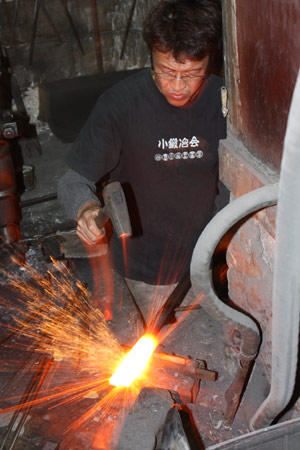What I was preparing for breakfast was nothing fancy. In fact, it was just some leftovers on their way to being reincarnated in an omelette. But as I chopped onions and tomatoes, I couldn't help but feel like a master chef. Had there been no one else around, I would have probably narrated what I was doing to an imaginary audience. The secret to my delusions of kitchen grandeur was my new knife - a 135mm Nakiri vegetable knife from the Sakai-Tohji Shigemitsu stainless series. It's a beauty, with its black laminated plywood handle and stainless steel blade. The truth is, it's the most ordinary Japanese Hocho kitchen knife in the Sakai-Tohji edged tool catalog, but it's enough to make me feel like an imperial chef. The term "hocho" refers to knives used in preparing food, and was originally the name of a legendary cook who appears in the Chinese classical writing "Zhuangzi." The Zen sect was introduced from China to Japan in the 12th century, and in the 14th century, Honzen cooking was established. The hocho method was used in this very strict ritual cooking, where the host would chop the food in front of the guests. With a hocho in his right hand and chopsticks in the other, the host would display his knife expertise, his hands never touching the food.

Enami Tadashi, a nationally certified knife forger, makes a sushi knife by hammering two plates of iron and carbon steel. Candice Montenegro
The world-famous Sakai blades originated in the 5th century, when specialists on agricultural implements, cutting tools, and casting were recruited from all over the country. Blacksmiths were gathered to forge tools for making over 100
tumuli or tomb stones, including Emperor Nintoku's burial mound, the Nintoku-ryo Tumulus, one of the world's three largest imperial mausoleums. Sakai rose to fame during the Edo Period in the 17th century when the Tokugawa Shogunate honored them with the words "Sakai Kiwame" that guarantees the product's authenticity. In 1982, the Minister of International Trade and Industry (now Minister of Economy, Trade and Industry) appointed the Sakai Traditional Blade as a "Traditional Craft Product." At the Federation of Sakai Blades Commerce and Industry Association, Director Keizo Shinoda says his family began the craft in 1905. "This means we have a 206-year history. But this building has an even longer history - 250 years," he says, gesturing to the traditional town house. He explains that the second floor is much shorter than the first floor because samurai and shogun used to pass through the town. "They have to kneel down, and we are not allowed to see the face of the samurai, so we minimize the height of the window and the second floor," he says. A few blocks away is the workroom, where Shinoda introduces Enami Tadashi, who demonstrates the knife forging process. He is a nationally certified Master of Traditional Crafts, and is one of less than ten people in Sakai recognized by the national Japanese government. "In other parts of Japan they also produce knives. However, the production process is a little bit different. In other regions they just use a pressing machine, and shape out the knife form. Here, he attaches two plates, iron and carbon steel plates by hammering and forging. This is a special technique unique to Sakai," says Shinoda.

Sakai's carbon-steel hocho knives are known for being the choice knife of many chefs around the world. Candice Montenegro
First, a piece of steel covered in acidic powder is welded to hot iron at a temperature of about 900 C. The flattened iron is then heated to about 600 C and shaped in the form of a knife. "In summertime when the outside temp is around 33 or 40 degrees the temperature of this room goes up to 50 degrees Celsius, but in the wintertime, this is a very good job. He has to stay in front of the fire all the time," says Shinoda. After shaping, the knife is allowed to cool naturally to prevent distortion. Then, the knife is hammered at room temperature to flatten the surface. Shinoda explains that a long time ago, the knives were hammered manually, but today they use a belt hammer, with a pedal to control it. "This was like an industrial revolution for us," he says. The knife is then placed on a cutting guide and unnecessary parts are removed. With an electric grinder, the edges are smoothed out before the knife is coated with mud and dried near the back of the furnace. Then the knife is tempered, heated to 800C, then cooled quickly by dipping into a bucket of water. After that, it is heated once more to 200C and cooled naturally to strengthen the knife. Only then does the knife go through stages of polishing - rough, fine, medium, hazed, and the final polishing.

Keizo Shinoda, director of the Federation of Sakai Blades Commerce and Industry Association, shows one of the older blade weapons forged in Sakai. Candice Montenegro
Hocho knives in Sakai are made using the same technique used in the Nara Period, when the Japanese produced swords that would not bend or deflect, and were of course very sharp. I couldn't wait to try my knife, but bringing it out at a restaurant seemed unwise. When I needed to sew some buttons, the opportunity presented itself and I used the knife to cut thread. I was delighted to discover that the swishing sound effect in movies isn't just an effect but the actual sound of a sharp edge severing something. Its subtle sharpness is the most obvious reason to love my new knife. But apart from that, it's also the story behind it - the hundreds of years of craftsmanship, and the care with which it was forged in the small workshop. And with a blade fit for a samurai sword, who wouldn't feel like a professional cook? -
YA, GMA News 





